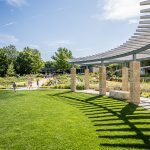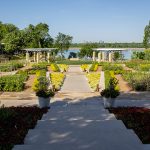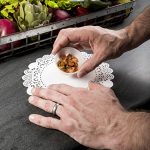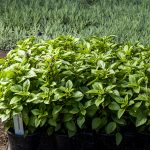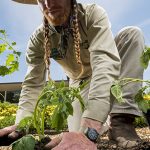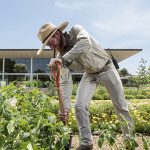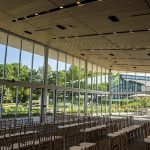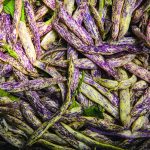The Dallas Arboretum’s new building is architecturally beautiful and the view is captivating. Follow a seed’s journey at the new development’s farm-to-table mission.

Preston Willms is an East Dallas native who oversees the garden as horticulture manager. (Photo by Danny Fulgencio).
A Tasteful Place, the Dallas Arboretum and Botanical Garden’s latest development, is either the city’s most brilliant educational attraction with stunning views of downtown Dallas or another development reducing the lake’s natural area.
In any case, couples flock here to take engagement photos. The building is architecturally significant and the farm-to-table program is revolutionary.
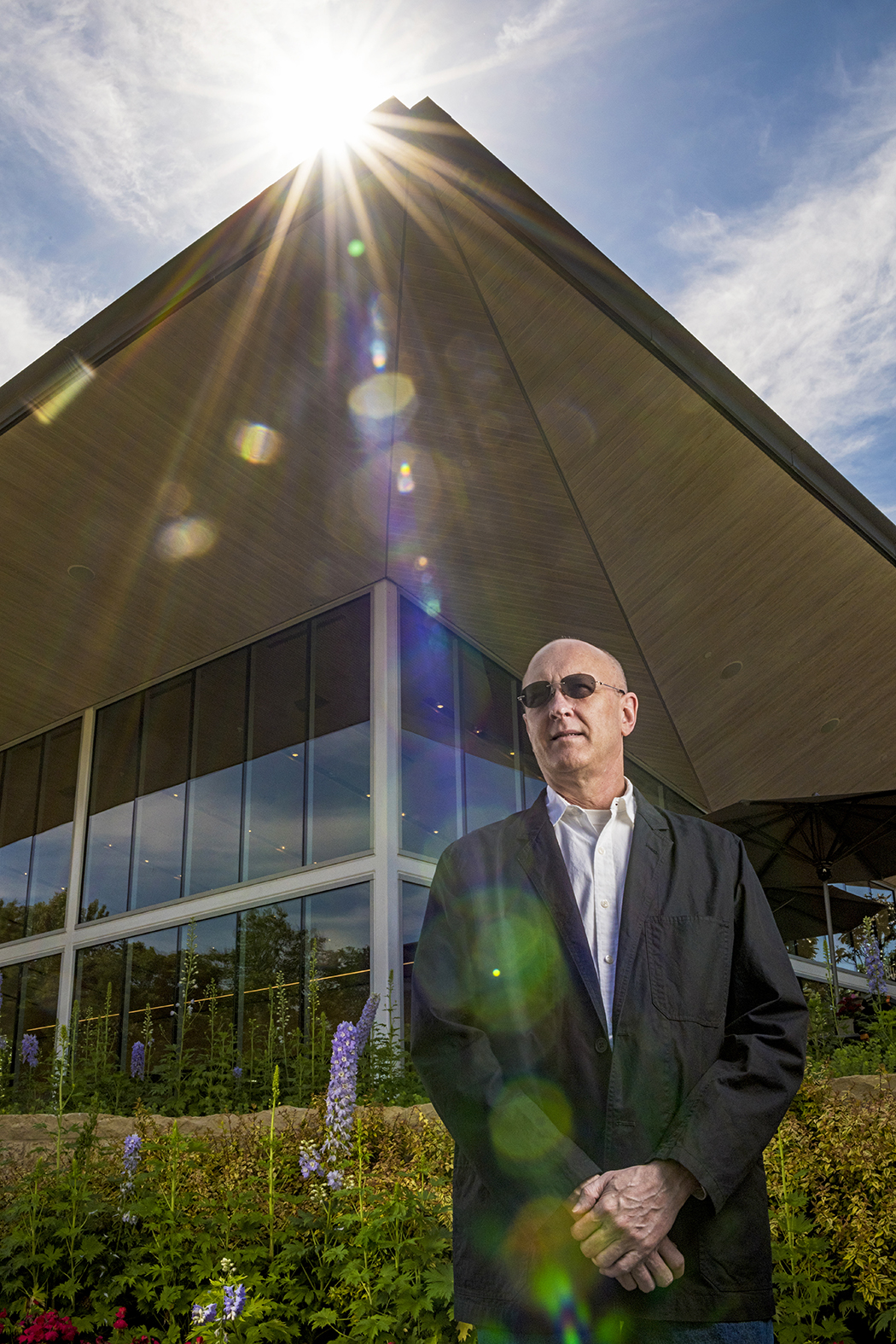
Architect Russell Buchanan (Photo by Danny Fulgencio).
The structure, designed by architect Russell Buchanan (right), and the garden, designed by Chuck McDaniel, are design triumphs, according to Mark Lamster, architecture critic for The Dallas Morning News. The pavilion, a glass box with floor-to-ceiling windows, was described by Lamster as an exceptional work of modern public architecture. “Above, a roof of wooden slats conceals recessed lighting, and angles up like the wings of an airplane on the exterior of the structure, creating a broad overhang that shields a generous patio from the sun and the elements,” Lamster says.
A 1980’s master plan for the arboretum, which included a sculpted-hedge maze, a six-story conservatory, dormitories for research students and an observation tower with views of downtown, received protests from neighbors, as did a plan to build an overflow parking lot at Winfrey Point in 2012. But the newest development received mostly glowing reviews.
A Tasteful Place, a $12 million development and 3.5-acre display garden, is on trend with the farm-to-table movement, emphasizing growing food locally and eating healthful ingredients. More than just something pretty to look at, the development is a working garden that produces vegetables and herbs for guests along with a cutting-edge culinary program.
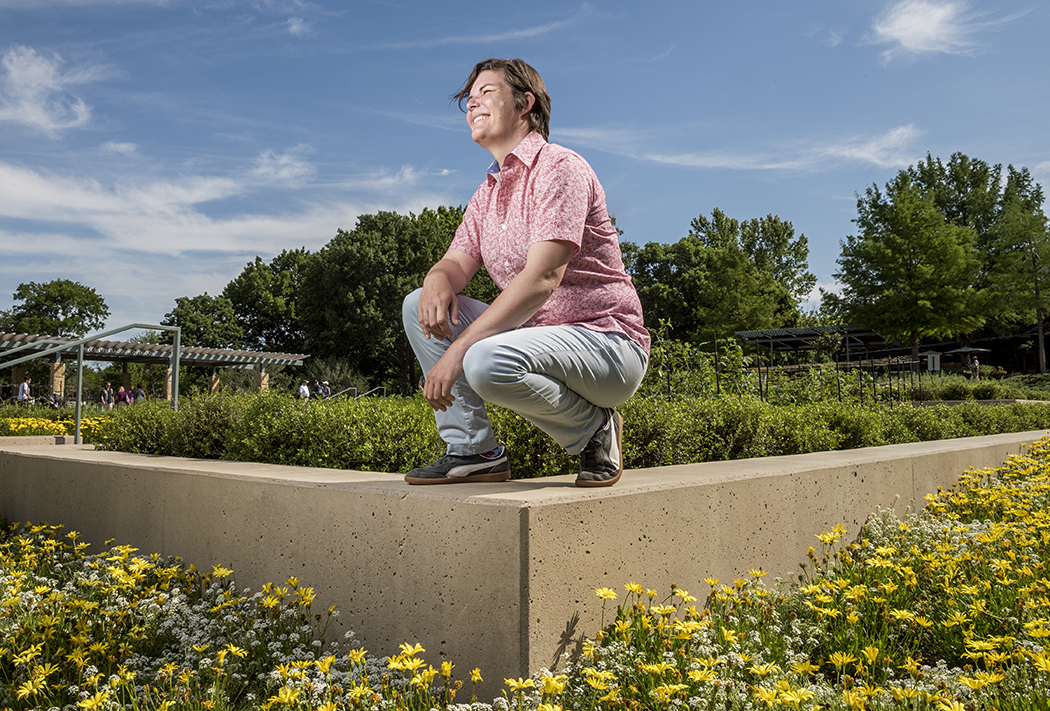
Dallas Arboretum’s a Tasteful Place Vice President of Horticulture Jenny Wegley (Photo by Danny Fulgencio).
Planting the seed
As plans began to take shape for A Tasteful Place seven years ago, Vice President of Horticulture Jenny Wegley (right) led a team that began to test which vegetables would best grow in the garden. With temperatures that can reach 100 degrees for months at a time and winters that get the occasional snow, growing vegetables 12 months out of the year was no easy task.
The horticulture team worked for years in the Arboretum’s greenhouse to gather data on the vegetables and varieties that would do best in the new space. Seedlings are grown to maturity and then transported to the Arboretum to provide an example of what can grow at that time of year. Lettuces, cabbages and cauliflower grew in the garden during the winter. Spring boasted beans. Tomatoes, peppers and okra are summer highlights.
This will be A Tasteful Place’s first summer, and Wegley is cautiously hopeful about the garden’s ability to sustain productivity through the summer. Growing vegetables that are both delicious and aesthetically pleasing throughout the year is rare. Wegley has been pleased with the results so far.
“It will be interesting to see how it pulls through,” she says. “It is going to be a great challenge.”
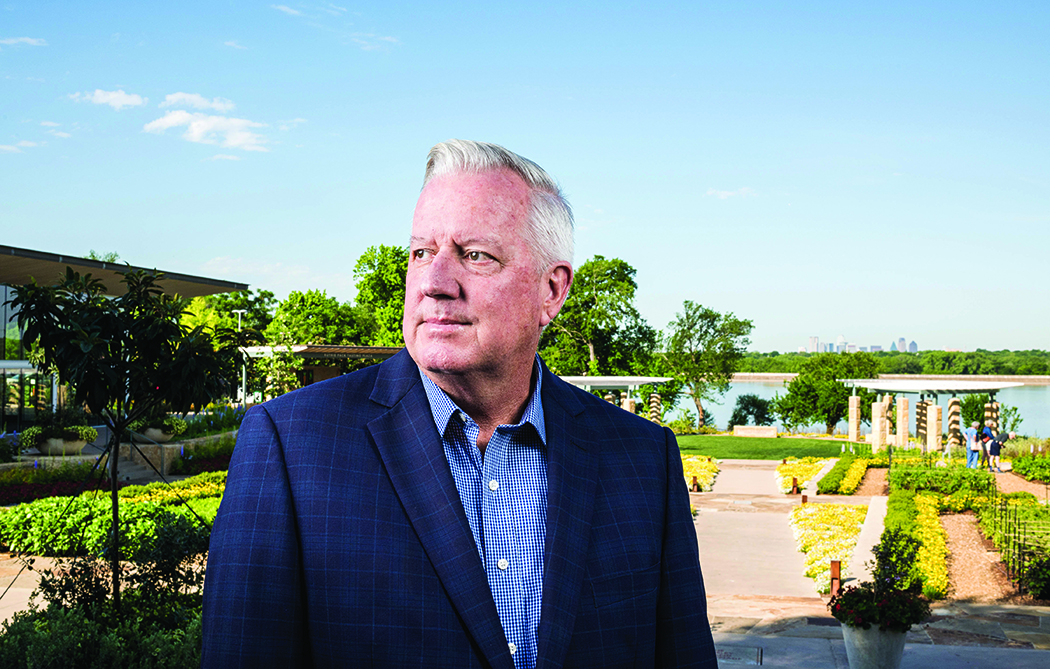
Dave Forehand helped design the view of the White Rock Lake and Downtown beyond (Photo by Danny Fulgencio).
Pretty produce
Guests enter A Tasteful Place at its highest point. As the garden slopes towards the view of White Rock Lake and downtown beyond, stone paths divide the neat rectangles of growing vegetables. A pavilion and lagoon flank the garden, which has a covered seating area and circular landing overlooking the lake that is destined to host countless weddings.
Naud Burnett’s Kevin Clark worked on the lagoon’s design. Before development, the location had been a debris-filled drainage area. The pond that fills the space captures groundwater and is the largest body of water in the arboretum. It is hemmed in by a bridge, and a fountain is lit at night, spraying changing colors 20 feet in the air.
Vice President of Gardens Dave Forehand (below) says this space is the last to be developed by the arboretum. SWA Group did the design work for the garden, which includes four tiered potagers, which is French for “ornamental or kitchen garden.”
An outdoor kitchen provides samples from the garden. Fruit trees grow outside of the testing pavilion, which sits off center in the space, so as not to obstruct the view of the water. Some trees had to be moved from the space and replanted in the children’s garden.
“We thought we wanted a little herb garden in the arboretum,” Forehand says with a smile. “It grew into more than an herb garden.”
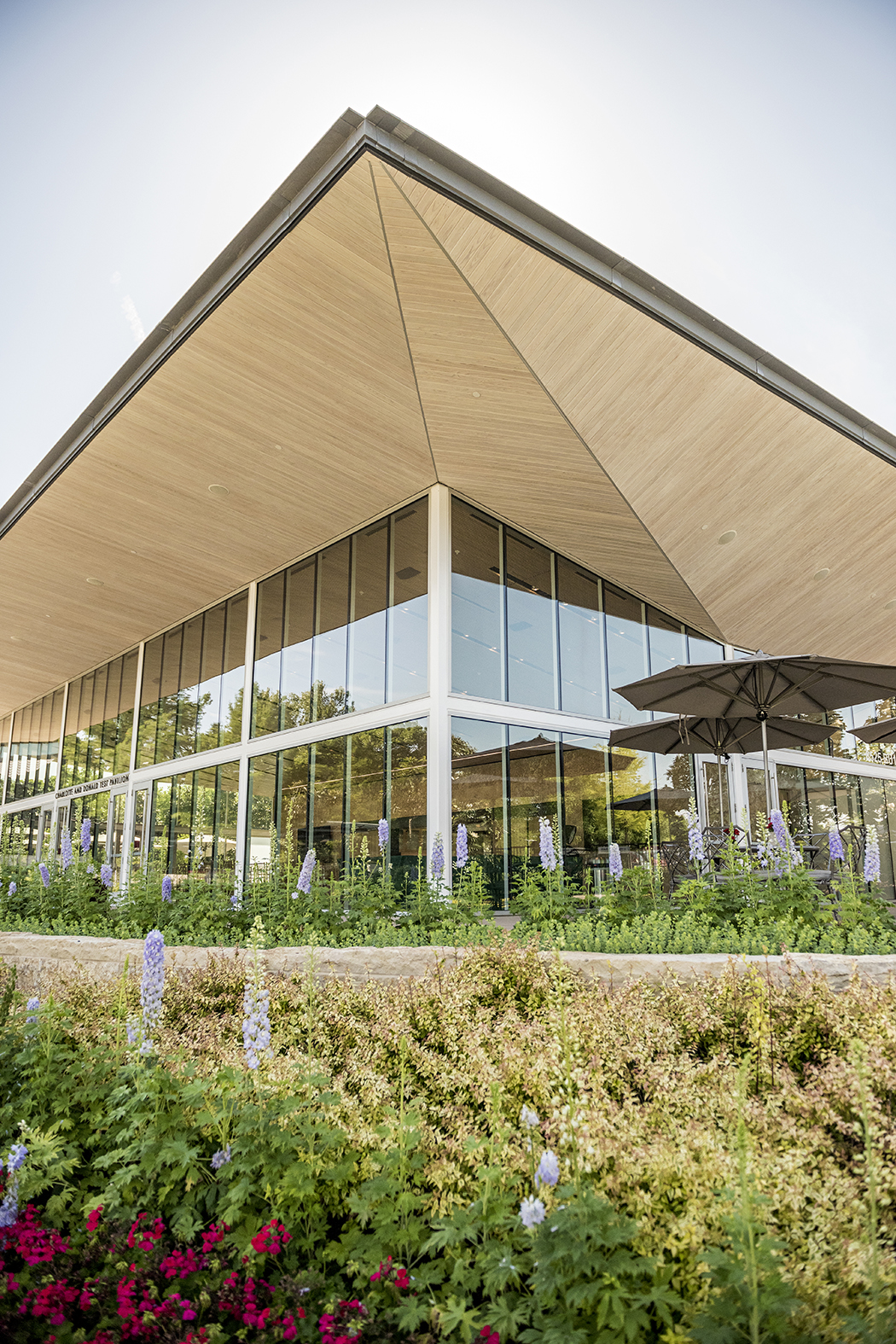
A Tasteful Place’s outdoor kitchen was designed by architect Russell Buchanan (Photo by Danny Fulgencio).
Kitchen with a view
Architect Russell Buchanan received a call from McDaniel about designing an outdoor kitchen for A Tasteful Place in 2013. As the vision for the space coalesced, plans shifted from an outdoor kitchen to an indoor facility that could be climate controlled. Buchanan recalls the thought process. “We have this great garden, but boy, it sure we would be nice if we could use it year-round,” he says.
Balancing the desire for the building to be used for educational purposes and weddings, Buchanan and the design team put together a plan. The kitchen accommodates both educational and catering needs and is outfitted with cameras so audiences can get a close look at demonstrations.
Buchanan designed the building’s interior to showcase the same limestone that is used throughout the arboretum. “It’s impossible not to get persuaded with how great it is,” Buchanan says.
The pavilion’s highest point is 20 feet. The overhang provides shade for garden-goers without looming over the vegetables, which need sun to grow. “The space allows the building and the garden to embrace one another.”
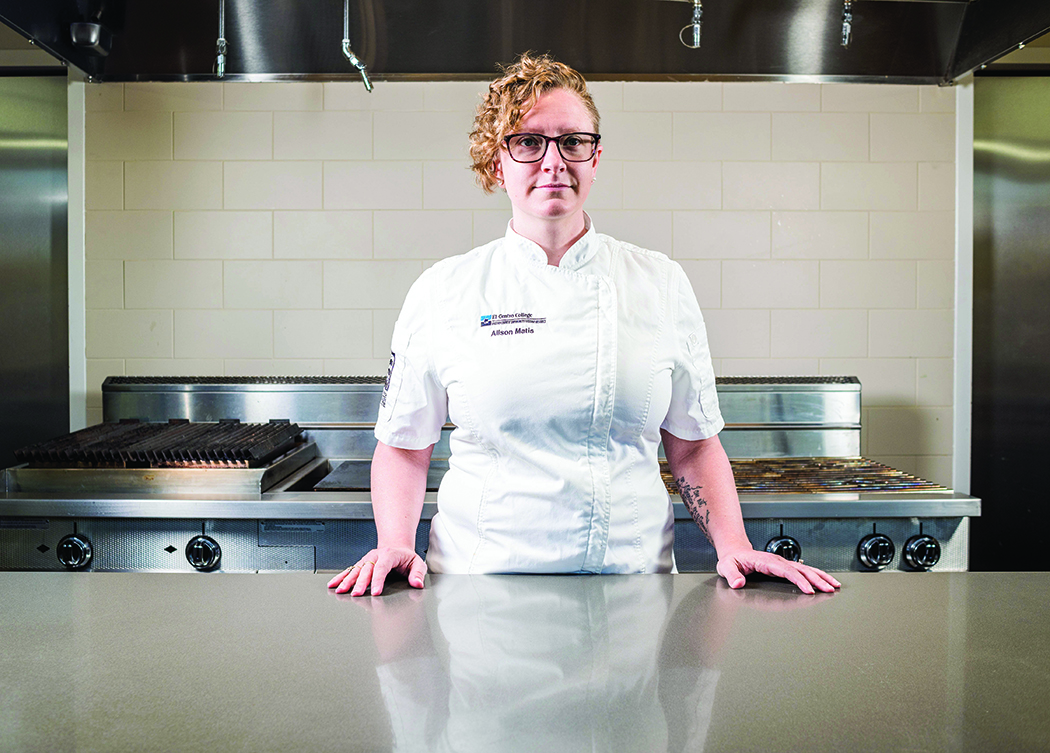
El Centro Food and Hospitality Institute Curriculum Director and Chef Alison Matis (Photo by Danny Fulgencio).
Garden to table
Vegetables and herbs harvested from the garden make their way to the testing kitchen, where El Centro Food and Hospitality Institute Curriculum Director and Chef Alison Matis (above) turns them into treats for guests to enjoy.
Visitors can attend the demonstrations with the price of admission. They fill the Test Pavilion on Monday mornings to take in Matis’ cooking demonstration, jokes and soapbox speeches about making your own salad dressing. They learn how to cook with ingredients from the garden, cooked with tools found in most kitchens.
Braised radishes and edamame salad were the stars one spring Monday. While most cooking classes involve ingredients, gadgets and know-how that the average chef doesn’t have, Matis works to make sure her recipes are practical and fresh.
“I think about what I am doing and what people have at home,” she says. “That is what will make it successful.”
Matis works for the culinary arts program at El Centro College downtown and provides an entertaining demonstration. “The crowd usually laughs at all my dad jokes,” she says.
The menu rotates monthly with changes in the garden, and Matis uses the list of what is being grown to plan her demonstrations. In a city with more restaurants than any in the nation, Matis knows the importance of cooking fresh and healthy food at home. “Seeing vegetables used in a different way is crucial to our society.”
- Dallas Arboretum’s A Tasteful Place (Photo by Danny Fulgencio).
- Fresh produce from Dallas Arboretum’s A Tasteful Place (Photo by Danny Fulgencio).
SaveSave

